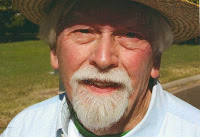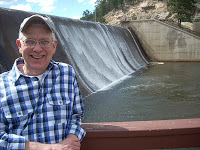Finally the rain softly and lightly announced its arrival. Little by little the drops became bigger and more insistent. Finally it fell with full force pelting the window panes. A couple of claps of thunder and just as suddenly as the cloud burst had come, the clouds opened up and there was the sun again.
With umbrella in hand I left the house headed for my office. The sidewalks were all shiny and washed and gutters were still flooded with the tidal wave headed for the drain.
The walk to the office gave me the time to reflect on the long ago rainy time when we were six or seven. Four of us were playing “Kick the Can” in a vacant lot near the edge of town. A rainstorm like the one today came up and being caught all drenched, all of us simply stripped naked and proceeded to dance in the rain like little elves escaping the wolf in the forest.
The merriment was in full blast until a local constable arrived on the scene at the behest of the self-appointed morals squad, Mrs. Templeton. Hers was the only house near our play field.
We were rounded up with wet clothes in hand and sternly lectured to on the lack of morality and the nasty, dirty actions we were participating in.
Actually the thought of sex hadn’t even caught up with us at this age, except casually taking note of each others’ endowments, if even noticeable.
Another thought while walking, another time maybe five or seven years later evidencing the discovery magic of puberty and all of its causes and results. You could liken it to Pandora’s Box or letting the Genie or Johnny out of the bottle. With no thanks to Mrs. Templeton and later Sister Charles/Ophelia, some of we heathens began our long residence in the closet. I always envied my friend with the power and conviction to never get into a closet. He never needed to for he had always known who he was and the gay road was his high road. Some of us strayed down a path of conformity and even various degrees of happiness, then only to find the “honestly real me” before it was too late to live a liberated life.
At the intersection waiting for the “WALK” light I looked down at the curb and gutter to see the rain water and my memories wash down the drain, to wait for another rainy day and maybe the very right man to steal my heart away.
© 28 November 2016

